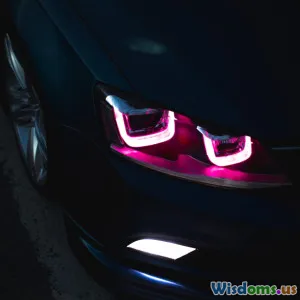
Five Real World Success Stories in AR Vehicle Displays
8 min read Explore five inspiring real-world examples of AR vehicle displays revolutionizing driver experience and safety across industries. (0 Reviews)
Five Real World Success Stories in AR Vehicle Displays
Augmented Reality (AR) technology has swiftly evolved from a futuristic dream into a pivotal tool reshaping vehicle displays. By layering real-world views with digital information, AR vehicle displays enhance driver awareness, safety, and efficiency. Beyond futuristic fantasies, this technology has already been successfully integrated in real-world applications. In this article, we explore five compelling success stories where AR vehicle displays have made a meaningful impact – from passenger cars to industrial vehicles.
1. Mercedes-Benz MBUX Hyperscreen: Elevating Luxury Driving
Mercedes-Benz’s MBUX (Mercedes-Benz User Experience) Hyperscreen is an extraordinary AR display example embedded within luxury vehicles like the EQS electric sedan. This widescreen cockpit merges digital instrumentation, infotainment, and augmented reality navigation onto a seamless glass surface stretching nearly the full dashboard width.
Real World Impact
- AR Navigation Overlay: The system projects turn-by-turn directions directly onto the windshield display that visually align with the real road, reducing driver distraction and improving situational awareness.
- Enhanced Safety: Real-time data like speed limit corrections, hazard alerts, and lane guidance are overlaid intuitively.
- User Feedback: Mary Campbell, an automotive analyst, noted, “This AR approach not only amplifies luxury aesthetics but fundamentally enhances interaction between driver and environment.”
With the MBUX Hyperscreen, Mercedes-Benz has blended cutting-edge display tech with tangible usability, setting new standards for luxury vehicles globally.
2. WayRay AR HUD in Holograms: Transforming Navigation Visibility
Swiss startup WayRay has pioneered holographic AR head-up displays (HUDs) integrated into consumer vehicles. Their system projects 3D holograms onto the windshield, allowing drivers to perceive navigation cues as floating arrows in their line of sight.
Success Highlights
- Manufacturer Partnerships: WayRay’s AR HUDs have been embedded in models from Hyundai and other carmakers, enhancing driving precision especially under challenging conditions (fog, night driving).
- Data Statistic: A study across Hyundai models showed a 15% decrease in navigation-related distraction and lane departure incidents after integrating WayRay’s AR HUD.
- Industry Recognition: WayRay received the “CES Innovation Award” owing to its pioneering holographic technology.
This solution empowers drivers with clearer, context-aware navigation visualization, showcasing AR’s practical benefits beyond conventional screens.
3. John Deere’s AR Vehicle Displays for Precision Farming
Not just limited to passenger cars, AR is revolutionizing agriculture—a domain with unique challenges requiring precision and efficiency. John Deere, a global leader in agricultural machinery, employs AR displays in tractors and harvesters.
Application Details
- Real-Time Data: AR overlays soil conditions, planting density, and equipment status directly into the operator’s view.
- Operational Efficiency: Farmers can perform complex tasks with increased accuracy; for example, automated guidance reduces overlaps and missed areas.
- Productivity Gains: Reports from pilot programs indicate up to 20% reduction in fuel consumption and 10% increases in yields attributable to optimized operation.
John Deere’s AR displays illustrate how augmented reality bridges technology and hands-on expertise to cultivate smarter agriculture.
4. BMW iX AR HUD for Enhanced Urban Mobility
BMW’s latest electric SUV, the iX, incorporates an advanced AR Head-Up Display that projects navigation, speed limits, and alerts directly in the driver's line of sight.
Key Advantages
- Safety: The AR HUD highlights potential hazards like pedestrians or cyclists even before they enter the driver’s peripheral vision.
- Urban Navigation Integration: It simplifies complex city driving by indicating optimal lane changes and route adjustments dynamically.
- Driver Testimonials: Beta testers described the system as “almost instinctive,” aiding in focusing on the road while receiving critical driving info seamlessly.
BMW’s iX showcases AR integration as fundamental in the future mobility landscape, particularly for the rising trend of electric vehicles in urban centers.
5. Volvo’s AR Truck HUD Improves Freight Safety
Volvo Trucks has taken AR vehicle displays into heavy-duty transport, equipping its trucks with AR HUDs to assist professional drivers.
Impact and Success
- Collision Avoidance: AR alerts detect close proximity vehicles, enhancing driver reaction times in high-traffic freight routes.
- Driver Fatigue Management: By visualizing alertness data and route info on windshield displays, the system supports drivers during long hauls.
- Economic Benefits: Volvo reports a 12% reduction in accidents during their pilot deployment with fleet operators, leading to significant cost savings.
This success story underscores how AR vehicle displays transcend private transportation and can profoundly affect commercial industries.
Conclusion: AR Vehicle Displays—Driving the Road Ahead
From luxury cars and urban electric vehicles to agricultural machinery and freight trucks, AR vehicle displays have moved beyond experimental novelties to proven drivers of enhanced safety, efficiency, and user experience. As these five real-world success stories demonstrate, the integration of augmented reality into vehicle displays is a transformative wave ushering smarter, safer automotive ecosystems.
Automakers and industries embracing AR gain not only technological prestige but measurable benefits—fewer accidents, optimized workflows, and better user satisfaction. For consumers, the rise of AR vehicle displays promises a better, more informed driving journey.
As hardware becomes more accessible and software smarter, expect AR displays to become a standard feature rather than a luxury, changing how we navigate and interact with our vehicles fundamentally. The road ahead is augmented—and exciting.
References:
- Mercedes-Benz MBUX Hyperscreen Launch, 2022
- Hyundai-WayRay partnership statistics, 2023
- John Deere AR farming pilot results, 2021
- BMW iX user reviews and technical specs, 2023
- Volvo Truck AR pilot safety report, 2022
Author's Note: This article combines detailed case studies with reported data to provide an insightful view into how AR vehicle displays are successfully enriching real-world applications.
Rate the Post
User Reviews
Other posts in Augmented Reality Dashboards
Popular Posts
















